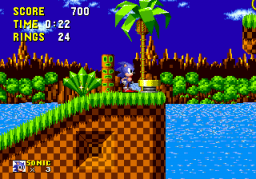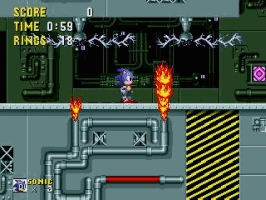Forum Links
Play Sonic the Hedgehog Online
Thread Information
Views
1,273
Replies
0
Rating
0
Status
OPEN
Thread
Creator
Creator
Redrunelord
11-24-11 10:39 AM
11-24-11 10:39 AM
Last
Post
Post
Redrunelord
11-24-11 10:39 AM
11-24-11 10:39 AM
System
9.2
Views: 514
Today: 0
Users: 2 unique
Today: 0
Users: 2 unique
Thread Actions
Order
Sonic the Hedgehog
Game's Ratings
Overall
Graphics
Sound
Addictiveness
Depth
Story
Difficulty
Average User Score
9.2
8.4
8.9
8.2
7.1
6.7
6.4
11-24-11 10:39 AM
Redrunelord is Offline
| ID: 503688 | 1227 Words
| ID: 503688 | 1227 Words
Redrunelord
Level: 66





POSTS: 699/1049
POST EXP: 118329
LVL EXP: 2338214
CP: 2807.5
VIZ: 93325

POSTS: 699/1049
POST EXP: 118329
LVL EXP: 2338214
CP: 2807.5
VIZ: 93325

Likes: 0 Dislikes: 0
The danger with any capitalist system is a true monopoly: if a single party has the monopoly in finances, then they are going to maintain said monopoly and what they says goes. The video game industry also flies like this: should a single company have the vast majority of the finances, support and resources, then they could do essentially whatever they want. Nintendo had a majority, technically, during the late 80's and early 90's, but they did have a major competitor on the console market: Sega. Sega had significant resources and some good games, but they just were not able to appeal to the masses with a central character, like Nintendo was doing with Mario. Then came Sonic. For the first time, Sega managed to give Nintendo a real punch in the gut, and Sonic the Hedgehog rocketed into the mainstream. The game that was meant to try and rival Mario put up a bitter fight until Sony finally knocked Sega's console market onto it's knees. Nonetheless, Sonic still appears in games to this very day which is testament to his legacy and the fight he put up against Mario and Zelda. Yet, about twenty years later, do the original Sonic the hedgehog game he debuted in hold up? A first impression makes a huge difference in preparing a flagship character and franchise, so this starts with how the game looks. Visually, the game is still very colorful to this day. A very bright character for a generally bright game. The visuals are 16 bit so they generally are superior to Mario's 8 bit counterpart (Though Sega also had a sonic game on the Master System). Even for 16 bit, they are fairly well done and it is clear that Sega put a lot of effort into making this an appealing game to look at. The areas are divided into a few possibly zones, and each major zone got a different theme to it. For an arcade game, the visuals are very good, with fairly fluid animation even for the console's standards. As well, the images were perfect for both children and adults, with a colorful style for children but not so much as to turn parents away either. Overall it is excellent. The sound department isn't as good though, but it still works. The key thing with the audio is that, like many games following similar tones, is that it is bright. Just like all video games with generally bright sound tracks, it follows the same advantages and disadvantages. The advantage is mainly that it gets the player into an almost adventurous mood, but the disadvantage is tolerance. This is applied to both the music and sound effects. The story...is virtually non-existent in the video game. The basic premise is that Dr. Robotnic is threatening the zones with his robotic creations and Sonic has to stop his industrial movement. While this would be expanded in later games and other media (Like most of the cartoons and ) What must still be considered is that this is an Arcade game, and the story don't matter nearly as much as the game play does. As well, it's direct competition still stuck to it's save the princess formula despite already having several games to develop it further, so for the time it can't be criticized. The game play is side scrolling at high velocities to reach the end of the level. To quote the Nostalgia Critic, he "Has weapons of mass acceleration." the levels are a lot larger proportionately than some of it's contemporaries, and it set the bar for future games following a similar style. The basic idea is to race towards the end of the stage before the timer hits 10 minutes. Every few stages, there would be a boss battle with Dr. Robotnic. The player runs across the stages collecting rings, and these rings acts as a shield of sorts. Should the player get hit by an enemy or hit some spikes without any rings, they lose a life and go back to the last checkpoint (a lamp post). If they have any rings, then the attack blasts all the rings out of the player, saving them from death. Since the rings flashes on screen for a brief moment, it is technically possible take a lot of abuse provided the player collects at least one ring before they fade away. Sonic will also be able to break mechanical blocks where inside a shield is waiting where sonic is immune to any an all damage. This is useful for the more hazardous areas and is recommended in grabbing whenever it can safely be done. As well, these blocks may also hold 10 rings which helps the player out a lot. Why? Sega took influence from games like Mario and designed Sonic so that this blue hedgehog will gain an extra life with every hundred rings. As well, building up rings enables the player to perform a bonus stage at the end of some "acts" or levels to try and get a Chaos emerald. This is an extra incentive to play the game well, and actually try to collect the rings. The game play works fairly well overall, but the big issue is due to being the genesis of the series. Some issues that transpire from being the first primarily has to do with building up speed. In later games, the easiest way to go faster is stay stationary and charge up a charge of sorts to make more difficult jumps. However, this first game didn't have that and the player would be required to go back a distance to build up momentum. While this is realistic, it is incredibly annoying, particularly in later stages when the player may be pressed for time. As well, while sonic is incredibly fast, he absolutely can not go fats all the time or otherwise will die due to unforeseen traps. In all fairness, this is true with most games that are 2D in design, so it isn't so much of a flaw as a minor irritation to impatient humans. Nonetheless, the game play is largely solid and works well for both kids and adults as the controls are straightforward, and the game play is simple on the whole. This does not mean the game is too easy. The difficulty is classic late 80's early 90's video game difficulty, but it is still not outrageous. It follows the formula of "start easy, grow more difficult as one progresses" instead of doing what "The Legend of Zelda II" did with having sporadic difficulty. This helps immensely to get players in and keep them in to overcome the challenges. This also helps replay value, as players can try to compete faster with higher scores and not be completely bored in the later stages. To conclude, how does this game hold up? It has its flaws associated with being the genesis of a series, yet it is still playable. It is generally recommended to stick to its sequels 2 and 3, or find one of the PC compilation packs that has several games in one, but it wouldn't do any psychological damage to revisit this title, or visit it for the first time to see how the series may have started. The 3D games may be questionable in quality, but this 2D title is not. Then came Sonic. For the first time, Sega managed to give Nintendo a real punch in the gut, and Sonic the Hedgehog rocketed into the mainstream. The game that was meant to try and rival Mario put up a bitter fight until Sony finally knocked Sega's console market onto it's knees. Nonetheless, Sonic still appears in games to this very day which is testament to his legacy and the fight he put up against Mario and Zelda. Yet, about twenty years later, do the original Sonic the hedgehog game he debuted in hold up? A first impression makes a huge difference in preparing a flagship character and franchise, so this starts with how the game looks. Visually, the game is still very colorful to this day. A very bright character for a generally bright game. The visuals are 16 bit so they generally are superior to Mario's 8 bit counterpart (Though Sega also had a sonic game on the Master System). Even for 16 bit, they are fairly well done and it is clear that Sega put a lot of effort into making this an appealing game to look at. The areas are divided into a few possibly zones, and each major zone got a different theme to it. For an arcade game, the visuals are very good, with fairly fluid animation even for the console's standards. As well, the images were perfect for both children and adults, with a colorful style for children but not so much as to turn parents away either. Overall it is excellent. The sound department isn't as good though, but it still works. The key thing with the audio is that, like many games following similar tones, is that it is bright. Just like all video games with generally bright sound tracks, it follows the same advantages and disadvantages. The advantage is mainly that it gets the player into an almost adventurous mood, but the disadvantage is tolerance. This is applied to both the music and sound effects. The story...is virtually non-existent in the video game. The basic premise is that Dr. Robotnic is threatening the zones with his robotic creations and Sonic has to stop his industrial movement. While this would be expanded in later games and other media (Like most of the cartoons and ) What must still be considered is that this is an Arcade game, and the story don't matter nearly as much as the game play does. As well, it's direct competition still stuck to it's save the princess formula despite already having several games to develop it further, so for the time it can't be criticized. The game play is side scrolling at high velocities to reach the end of the level. To quote the Nostalgia Critic, he "Has weapons of mass acceleration." the levels are a lot larger proportionately than some of it's contemporaries, and it set the bar for future games following a similar style. The basic idea is to race towards the end of the stage before the timer hits 10 minutes. Every few stages, there would be a boss battle with Dr. Robotnic. The player runs across the stages collecting rings, and these rings acts as a shield of sorts. Should the player get hit by an enemy or hit some spikes without any rings, they lose a life and go back to the last checkpoint (a lamp post). If they have any rings, then the attack blasts all the rings out of the player, saving them from death. Since the rings flashes on screen for a brief moment, it is technically possible take a lot of abuse provided the player collects at least one ring before they fade away. Sonic will also be able to break mechanical blocks where inside a shield is waiting where sonic is immune to any an all damage. This is useful for the more hazardous areas and is recommended in grabbing whenever it can safely be done. As well, these blocks may also hold 10 rings which helps the player out a lot. Why? Sega took influence from games like Mario and designed Sonic so that this blue hedgehog will gain an extra life with every hundred rings. As well, building up rings enables the player to perform a bonus stage at the end of some "acts" or levels to try and get a Chaos emerald. This is an extra incentive to play the game well, and actually try to collect the rings. The game play works fairly well overall, but the big issue is due to being the genesis of the series. Some issues that transpire from being the first primarily has to do with building up speed. In later games, the easiest way to go faster is stay stationary and charge up a charge of sorts to make more difficult jumps. However, this first game didn't have that and the player would be required to go back a distance to build up momentum. While this is realistic, it is incredibly annoying, particularly in later stages when the player may be pressed for time. As well, while sonic is incredibly fast, he absolutely can not go fats all the time or otherwise will die due to unforeseen traps. In all fairness, this is true with most games that are 2D in design, so it isn't so much of a flaw as a minor irritation to impatient humans. Nonetheless, the game play is largely solid and works well for both kids and adults as the controls are straightforward, and the game play is simple on the whole. This does not mean the game is too easy. The difficulty is classic late 80's early 90's video game difficulty, but it is still not outrageous. It follows the formula of "start easy, grow more difficult as one progresses" instead of doing what "The Legend of Zelda II" did with having sporadic difficulty. This helps immensely to get players in and keep them in to overcome the challenges. This also helps replay value, as players can try to compete faster with higher scores and not be completely bored in the later stages. To conclude, how does this game hold up? It has its flaws associated with being the genesis of a series, yet it is still playable. It is generally recommended to stick to its sequels 2 and 3, or find one of the PC compilation packs that has several games in one, but it wouldn't do any psychological damage to revisit this title, or visit it for the first time to see how the series may have started. The 3D games may be questionable in quality, but this 2D title is not. |
Vizzed Elite
Affected by 'Laziness Syndrome'
Registered: 05-01-11
Last Post: 4196 days
Last Active: 2358 days
| A Lone Samurai |
Affected by 'Laziness Syndrome'
Registered: 05-01-11
Last Post: 4196 days
Last Active: 2358 days
(edited by Redrunelord on 11-24-11 10:40 AM)


 User Notice
User Notice 






